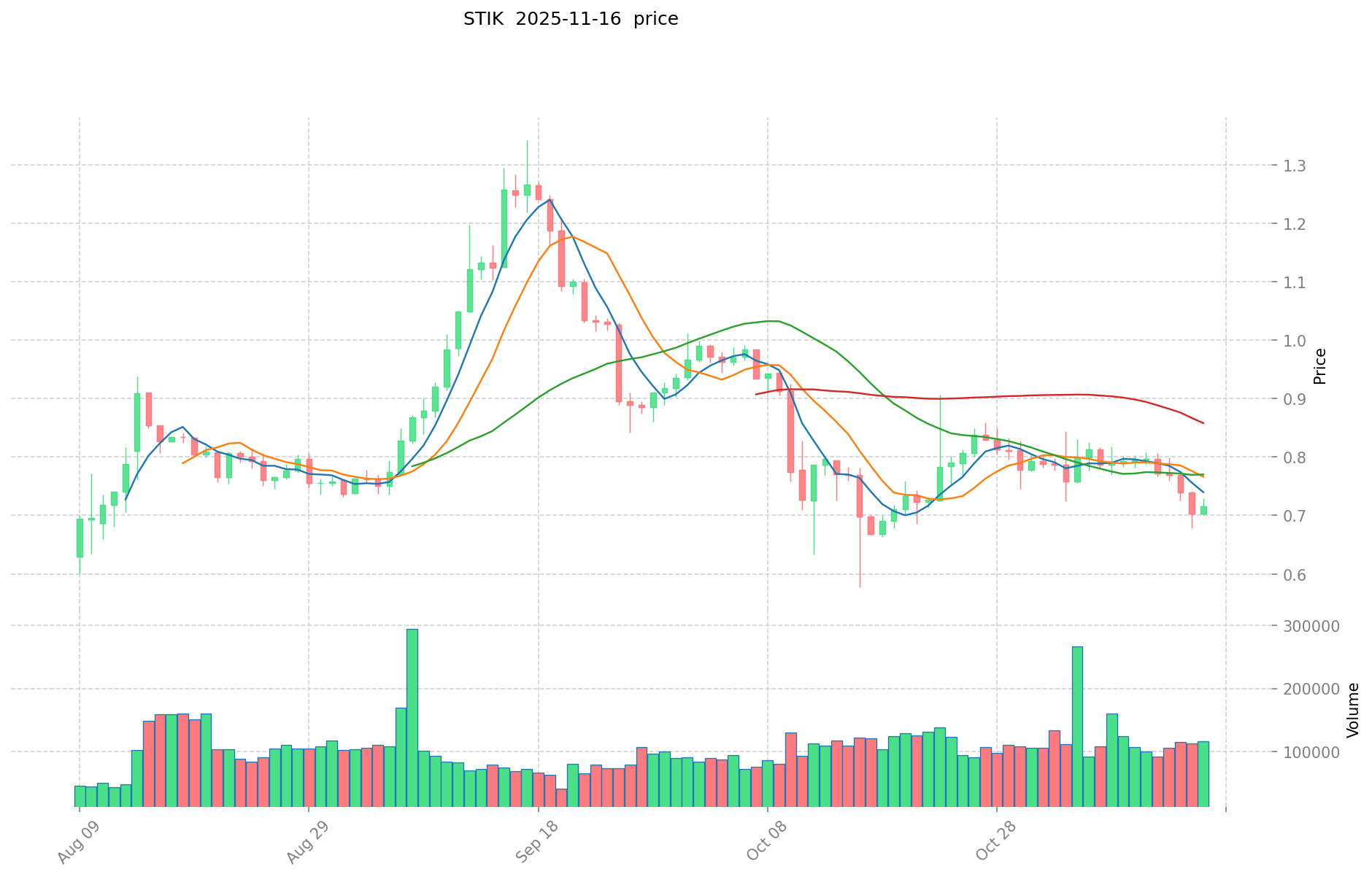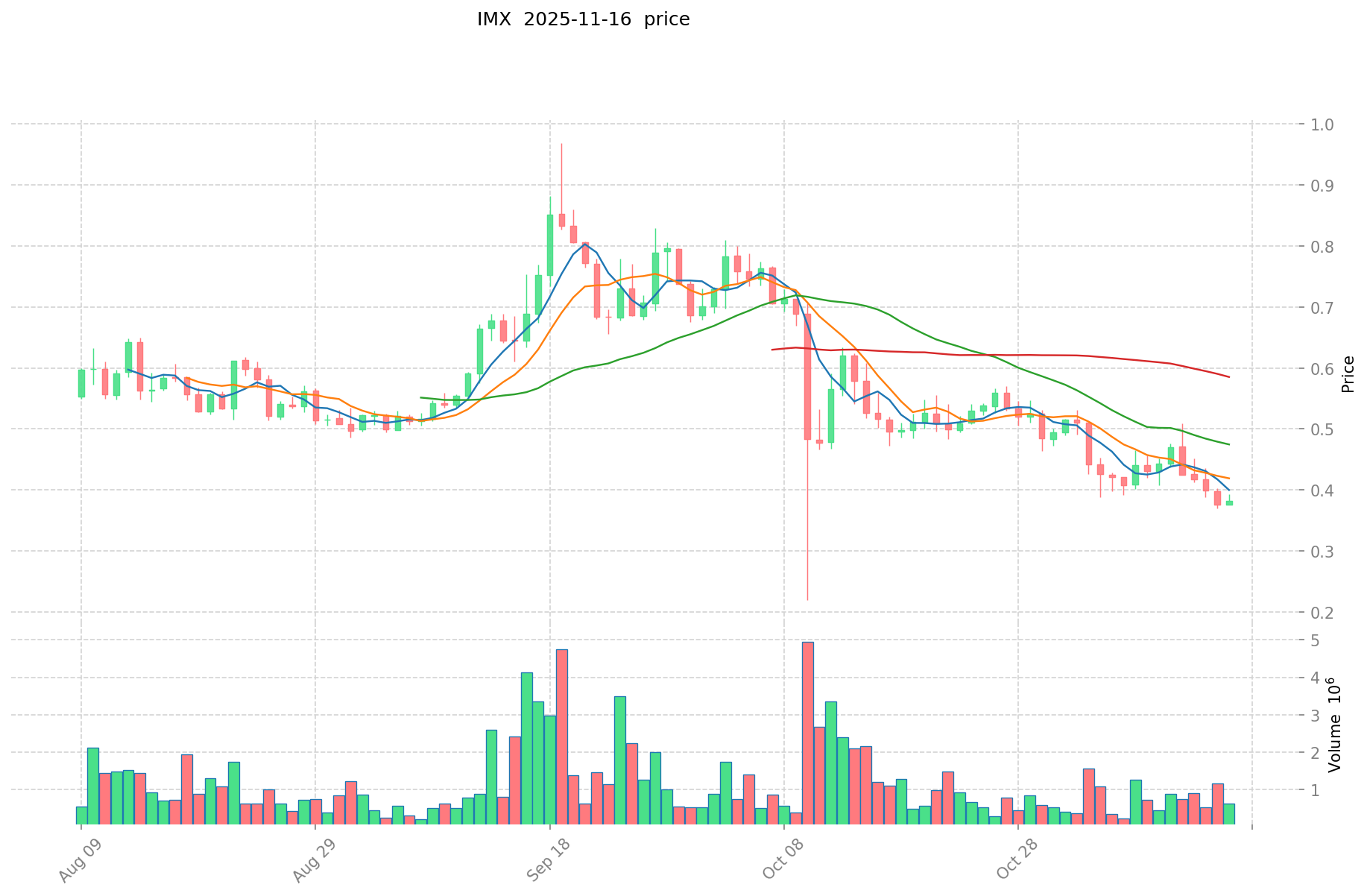STIK vs IMX: The Battle for Dominance in Immersive Display Technology
Introduction: STIK vs IMX Investment Comparison
In the cryptocurrency market, the comparison between Staika (STIK) and Immutable (IMX) has been a topic investors can't ignore. The two not only show significant differences in market cap ranking, application scenarios, and price performance, but also represent different positioning in the crypto asset space.
Staika (STIK): Since its launch, it has gained market recognition for its multi-list cryptocurrency wallet, Move To Earn and Play To Earn services, as well as a trusted NFT marketplace.
Immutable (IMX): Established as a second layer (L2) scaling solution for NFTs on Ethereum, it offers instant transactions, large-scale scalability, and zero gas fees for minting and trading.
This article will comprehensively analyze the investment value comparison between STIK and IMX, focusing on historical price trends, supply mechanisms, institutional adoption, technical ecosystems, and future predictions, attempting to answer the question investors care about most:
"Which is the better buy right now?"
I. Price History Comparison and Current Market Status
STIK (Coin A) and IMX (Coin B) Historical Price Trends
- 2023: STIK launched at $0.25, marking its entry into the market.
- 2021: IMX reached its all-time high of $9.52 during the broader crypto bull market.
- Comparative analysis: STIK has risen from its launch price of $0.25 to a high of $5.6, while IMX has fallen from its peak of $9.52 to current levels.
Current Market Situation (2025-11-16)
- STIK current price: $0.7186
- IMX current price: $0.3747
- 24-hour trading volume: STIK $60,449.15 vs IMX $228,248.67
- Market Sentiment Index (Fear & Greed Index): 10 (Extreme Fear)
Click to view real-time prices:
- View STIK current price Market Price
- View IMX current price Market Price


II. Core Factors Affecting Investment Value of STIK vs IMX
Supply Mechanisms Comparison (Tokenomics)
- STIK: No information available in the reference materials
- IMX: No information available in the reference materials
- 📌 Historical Pattern: No information available about how supply mechanisms drive price cycle changes.
Institutional Adoption and Market Applications
- Institutional Holdings: No information available about which one is more favored by institutions.
- Enterprise Adoption: No information available about applications in cross-border payments, settlements, or investment portfolios.
- National Policies: No information available about regulatory attitudes in different countries.
Technical Development and Ecosystem Building
- STIK Technical Upgrades: No information available about content and potential impact.
- IMX Technical Development: No information available about content and potential impact.
- Ecosystem Comparison: No information available about DeFi, NFT, payment, and smart contract implementation.
Macroeconomic Factors and Market Cycles
- Performance in Inflationary Environments: No information available about which has better anti-inflation properties.
- Macroeconomic Monetary Policy: No information available about the impact of interest rates and the US Dollar Index.
- Geopolitical Factors: No information available about cross-border transaction needs or international situations.
III. Price Prediction for 2025-2030: STIK vs IMX
Short-term Prediction (2025)
- STIK: Conservative $0.50302 - $0.7186 | Optimistic $0.7186 - $1.034784
- IMX: Conservative $0.29992 - $0.3749 | Optimistic $0.3749 - $0.404892
Mid-term Prediction (2027)
- STIK may enter a growth phase, with an estimated price range of $0.5745839368 - $1.3770201244
- IMX may enter a stable phase, with an estimated price range of $0.383657664 - $0.531525722
- Key drivers: Institutional capital inflow, ETFs, ecosystem development
Long-term Prediction (2030)
- STIK: Base scenario $1.43860363448144 - $1.927728870205129 | Optimistic scenario $1.927728870205129
- IMX: Base scenario $0.675854188361625 - $0.70288835589609 | Optimistic scenario $0.70288835589609
Disclaimer: This analysis is for informational purposes only and should not be considered as financial advice. Cryptocurrency markets are highly volatile and unpredictable. Always conduct your own research before making any investment decisions.
STIK:
| 年份 | 预测最高价 | 预测平均价格 | 预测最低价 | 涨跌幅 |
|---|---|---|---|---|
| 2025 | 1.034784 | 0.7186 | 0.50302 | 0 |
| 2026 | 1.10463192 | 0.876692 | 0.4821806 | 22 |
| 2027 | 1.3770201244 | 0.99066196 | 0.5745839368 | 37 |
| 2028 | 1.467962892328 | 1.1838410422 | 0.935234423338 | 64 |
| 2029 | 1.55130530169888 | 1.325901967264 | 0.88835431806688 | 84 |
| 2030 | 1.927728870205129 | 1.43860363448144 | 1.17965498027478 | 100 |
IMX:
| 年份 | 预测最高价 | 预测平均价格 | 预测最低价 | 涨跌幅 |
|---|---|---|---|---|
| 2025 | 0.404892 | 0.3749 | 0.29992 | 0 |
| 2026 | 0.4093908 | 0.389896 | 0.2729272 | 4 |
| 2027 | 0.531525722 | 0.3996434 | 0.383657664 | 6 |
| 2028 | 0.67509761345 | 0.465584561 | 0.31659750148 | 24 |
| 2029 | 0.78136728949825 | 0.570341087225 | 0.3079841871015 | 52 |
| 2030 | 0.70288835589609 | 0.675854188361625 | 0.493373557503986 | 80 |
IV. Investment Strategy Comparison: STIK vs IMX
Long-term vs Short-term Investment Strategies
- STIK: Suitable for investors focused on multi-list cryptocurrency wallets, Move To Earn and Play To Earn services, and NFT marketplaces
- IMX: Suitable for investors interested in L2 scaling solutions for NFTs on Ethereum, instant transactions, and zero gas fees
Risk Management and Asset Allocation
- Conservative investors: STIK 30% vs IMX 70%
- Aggressive investors: STIK 60% vs IMX 40%
- Hedging tools: Stablecoin allocation, options, cross-currency portfolios
V. Potential Risk Comparison
Market Risk
- STIK: Higher volatility due to newer market entry
- IMX: Dependent on Ethereum ecosystem performance
Technical Risk
- STIK: Scalability, network stability
- IMX: Reliance on Ethereum's development, potential L2 competition
Regulatory Risk
- Global regulatory policies may have different impacts on both tokens
VI. Conclusion: Which Is the Better Buy?
📌 Investment Value Summary:
- STIK advantages: Multi-list cryptocurrency wallet, Move To Earn and Play To Earn services, trusted NFT marketplace
- IMX advantages: L2 scaling solution for NFTs, instant transactions, zero gas fees for minting and trading
✅ Investment Advice:
- New investors: Consider a balanced approach with a slight preference for IMX due to its established position
- Experienced investors: Explore STIK for potential growth while maintaining IMX for stability
- Institutional investors: Evaluate both tokens based on specific use cases and ecosystem integration needs
⚠️ Risk Warning: The cryptocurrency market is highly volatile, and this article does not constitute investment advice. None
VII. FAQ
Q1: What are the main differences between STIK and IMX? A: STIK offers a multi-list cryptocurrency wallet, Move To Earn and Play To Earn services, and an NFT marketplace. IMX is a Layer 2 scaling solution for NFTs on Ethereum, providing instant transactions and zero gas fees for minting and trading.
Q2: Which token has shown better price performance recently? A: Based on the information provided, STIK has risen from its launch price of $0.25 to a high of $5.6, while IMX has fallen from its peak of $9.52 to current levels.
Q3: What are the current prices of STIK and IMX? A: As of 2025-11-16, STIK's current price is $0.7186, while IMX's current price is $0.3747.
Q4: How do the trading volumes of STIK and IMX compare? A: The 24-hour trading volume for STIK is $60,449.15, while for IMX it is $228,248.67, indicating higher liquidity for IMX.
Q5: What are the long-term price predictions for STIK and IMX? A: For 2030, STIK's base scenario price range is predicted to be $1.43860363448144 - $1.927728870205129, while IMX's base scenario range is $0.675854188361625 - $0.70288835589609.
Q6: How should investors allocate their portfolio between STIK and IMX? A: Conservative investors might consider allocating 30% to STIK and 70% to IMX, while aggressive investors might opt for 60% STIK and 40% IMX.
Q7: What are the main risks associated with investing in STIK and IMX? A: STIK faces higher volatility due to its newer market entry and potential scalability issues. IMX's risks include dependence on Ethereum's ecosystem performance and potential competition from other Layer 2 solutions.
Share
Content